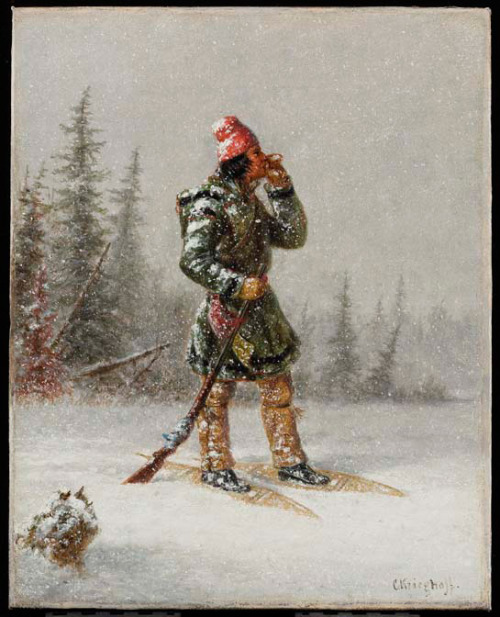What seems to strike me most in Krieghoff's paintings is how much attention has been paid towards the objects in each scene. Though the landscapes and people in Krieghoff's scenes are certainly beautiful in their romantic styling, the clothing, the furniture, and the textures are so finely painted that they demand the most attention from the observer.
An Officer`s Room in Montreal
I particularly love An Officer`s Room in Montreal. You can nearly feel the cushy softness of the fur blanket draped over the chaise by the fire, where you sit to gaze at the innumerable objects that add such coziness to the room, and scratch the friendly dogs absentmindedly after they've both wandered contentedly towards you and compete for your affection. The room itself is dry and maybe a bit too warm, but it is a welcome relief from the outside cold.
This officer appears to be an intellectual member of the merchant class (or wishes to present himself as such). The room is a 'cabinet of wonders,' filled with items acquired through trade and travel, samples of his intellectual interests. The traps above his desk reveal the origins of his trade as a fur trader, and the various pelts, beaded boots, slippers, and mitts strewn about the room demonstrate his interactions with First Nations. These boots, as well as the pair of snowshoes, have been warn - are not merely items for display - and so he also interacts with the land himself, he is not just a passive observer. The room is both a demonstration of the European Enlightenment as well as of Canadian entrepreneurial spirit and colonialism of the time.

Calling the Moose
1860
Winter was one of Krieghoff`s favourite seasons to depict in his work. The people in his paintings were fur traders newly arrived from England and Scotland, French Canadians who had already been been part of the landscape since the seventeenth century, and First Nations peoples who had known the winters around the St-Lawrence since time immemorial. He didn't just paint people in wintry scenes, he painted these people interacting with the landscape They were as much a part of these landscapes as any hill, river, or tree. He painted these people working, travelling, interacting, and having fun with winter.

An Early Canadian Homestead
1859
The snow in these scenes managed to accentuate the bright colours and fine detail in the fabrics of the people, furs, trees, houses, tools, and decorations he so carefully painted. Krieghoff painted people who loved bright colours for their clothing and houses in the depths of winter.I also love how his paintings are so animated. You can nearly hear the people in the paintings yelling to one another across a snowy yard, the winter wind blowing, the sound of crunching snow beneath mocassined feet, or a dog barking. Krieghoff's paintings demonstrated how winter in Canada near the St-Lawrence could be great fun and stunningly beautiful or utterly difficult and nearly hellish.

The Trapper's Return
1861

The Blizzard
1857
Not only did Krieghoff capture people living in the midst of winter, he captured the development of new social identities and was just as much a part of it as his subjects. The people in these scenes lived winter in such a way that it molded the way they viewed the world around them. Their experiences during this time were neither strictly those of First Nations or strictly those of Europeans; these experiences were part of a burgeoning notion - of a new sense - of what it was to be Canadian. Though the idea of what it means to be "Canadian" today is something quite complicated and the subject of ongoing study, a hint of its origins can certainly be found in the subjects of Krieghoff's paintings and how he chose to portray them.
Interesting stuff.
Wishing you all the best over these winter months!

No comments:
Post a Comment